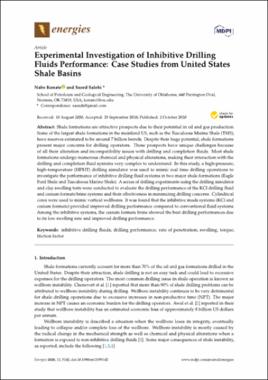| dc.contributor.author | Konate, Nabe | |
| dc.contributor.author | Salehi, Saeed | |
| dc.date.accessioned | 2020-11-04T18:59:22Z | |
| dc.date.available | 2020-11-04T18:59:22Z | |
| dc.date.issued | 2020-10-02 | |
| dc.identifier.citation | Konate, N., & Salehi, S. (2020). Experimental Investigation of Inhibitive Drilling Fluids Performance: Case Studies from United States Shale Basins. Energies, 13(19), 5142. doi:10.3390/en13195142 | en_US |
| dc.identifier.uri | https://hdl.handle.net/11244/325644 | |
| dc.description.abstract | Shale formations are attractive prospects due to their potential in oil and gas production. Some of the largest shale formations in the mainland US, such as the Tuscaloosa Marine Shale (TMS), have reserves estimated to be around 7 billion barrels. Despite their huge potential, shale formations present major concerns for drilling operators. These prospects have unique challenges because of all their alteration and incompatibility issues with drilling and completion fluids. Most shale formations undergo numerous chemical and physical alterations, making their interaction with the drilling and completion fluid systems very complex to understand. In this study, a high-pressure, high-temperature (HPHT) drilling simulator was used to mimic real time drilling operations to investigate the performance of inhibitive drilling fluid systems in two major shale formations (Eagle Ford Shale and Tuscaloosa Marine Shale). A series of drilling experiments using the drilling simulator and clay swelling tests were conducted to evaluate the drilling performance of the KCl drilling fluid and cesium formate brine systems and their effectiveness in minimizing drilling concerns. Cylindrical cores were used to mimic vertical wellbores. It was found that the inhibitive muds systems (KCl and cesium formate) provided improved drilling performance compared to conventional fluid systems. Among the inhibitive systems, the cesium formate brine showed the best drilling performances due to its low swelling rate and improved drilling performance. | en_US |
| dc.description.sponsorship | This research was partially funded by the Department of Energy National Energy Technology Laboratory under Award Number DE-FE0031575 (TUSCALOOSA MARINE SHALE LABORATORY).
Open Access fees paid for in whole or in part by the University of Oklahoma Libraries. | en_US |
| dc.language | en_US | en_US |
| dc.rights | Attribution 4.0 International | * |
| dc.rights.uri | https://creativecommons.org/licenses/by/4.0/ | * |
| dc.subject | Inhibitive drilling fluids | en_US |
| dc.subject | Drilling performance | en_US |
| dc.subject | Rate of penetration | en_US |
| dc.subject | Swelling | en_US |
| dc.subject | Torque | en_US |
| dc.subject | Friction factor | en_US |
| dc.title | Experimental Investigation of Inhibitive Drilling Fluids Performance: Case Studies from United States Shale Basins | en_US |
| dc.type | Article | en_US |
| dc.description.peerreview | Yes | en_US |
| dc.identifier.doi | 10.3390/en13195142 | en_US |
| ou.group | Mewbourne College of Earth and Energy::Mewbourne School of Petroleum and Geological Engineering | en_US |

